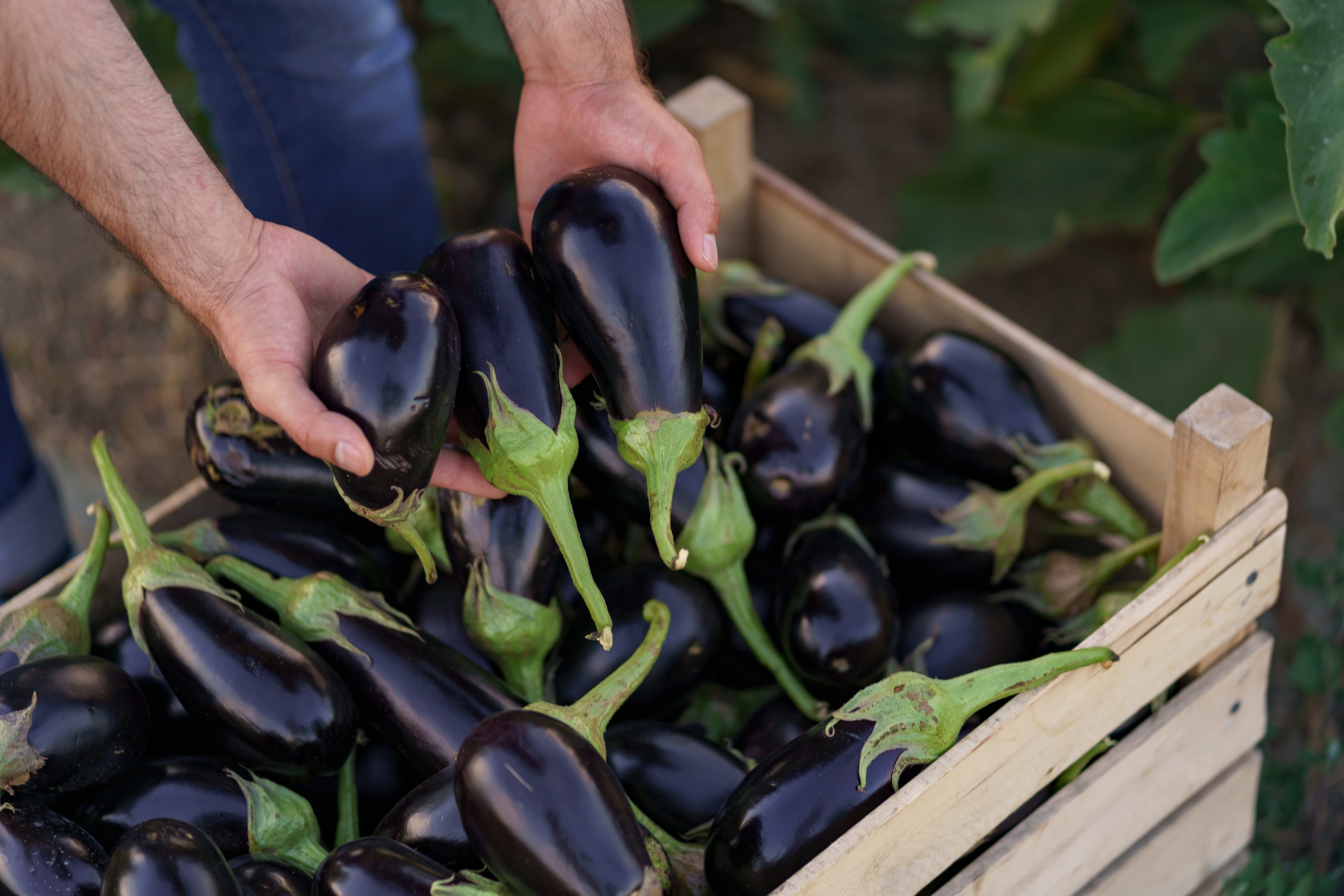Eggplant
Eggplant. Somewhat misunderstood and underappreciated, at least for many in North America. Eggplant is a humble vegetable that often does not get seen in haute cuisine. It is some of these rustic and modest "peasant" foods that many people think of as comfort food and home-cooked meals.
In Europe, the Middle East eggplant is also quite common. The French word is aubergine and many English-speaking countries refer to eggplant in its French term.
Eggplant is biologically a fruit, looking at the way that fruits grow from plants. In the food world we refer to it as a tender-fruited vegetable like tomatoes and okra.

Types of Eggplant
We see mostly dark purple coloured eggplants, either Italian (somewhat tear-drop shape), globe (large round), Japanese or Chinese (long and thin), Indian eggplant (small, round, purple), and sometimes graffiti eggplant (purple with white speckles). There are also white-skinned eggplants and a small variety of white eggplant which we can only presume that was where the name first came from.
Growing
It can grow here in Alberta but It requires lots of heat for growing and is very well-known across South Asia.
History
Eggplant likely originated in India. The British, who colonized India, also know it well and enjoy it. The West Indies once called it brown-jolly.
Fun Facts
Legend has it that eggplant skin was once burned and rubbed on teeth. When it gets rubbed off, teeth are whiter! (The Secrets of the Seed Vegetables, Fruits and Nuts p 32)
Did you know that the plural word for eggplant can either be eggplants or eggplant?
Ways to Cook
Eggplant is best when cooked although can be eaten raw.
The skin of eggplants is thick and some describe it as rubbery. (Like a wet suit!) It can taste bitter and sometimes the skin is removed, or the flesh inside is scraped out like with Baba Ganoush. Older eggplants stored for a long time will also taste more bitter. The raw flesh of eggplants is very much like a sponge. It can be squeezed and it also absorbs a lot of liquid like water and oil
Once cut, eggplant oxidizes (turns brown on the exposed edges). You can counter that by brushing or dipping pieces in a lightly acidulated solution but if preparing a hot dish like moussaka or eggplant lasagna then maybe the colour will be hidden and it's not a big deal!
Lighter coloured eggplants are much creamier and milder than the dark coloured purple varieties.
To salt or not to salt?
If someone is making eggplant parmesan or moussaka, for example, they should slice it thick and before breading and deep-frying or panfrying. Salting accomplishes three things; it seasons it, it removes some bitterness, and it draws out the water. Some chefs have strong preferences one way or another but think about the desired texture, overall seasoning, and workability of eggplant slices. Eggplants that are salted and left on paper towel to desiccate (dry out) become flimsy and soggy and can tear easily.
Toxicity
Nightshade vegetables (like eggplants, tomatoes, peppers, and potatoes) contain solanine, a toxic alkaloid. Do not eat leaves of nightshades and do not eat green parts of potatoes.
More on Cooking Eggplants
Some of our favourite videos
Alberta Eggplant Producers
Big Marble Farms
About this producerBroxburn Vegetables
About this producerFoods from this producer:
-
- Vegetables
Tomatoes
-
- Vegetables
- Tender-Fruited Vegetables
Eggplant
-
- Vegetables
Cucumber
-
- Vegetables
Lettuce
-
- Vegetables
Green Bean
-
- Fruit
Raspberry
-
- Vegetables
Onion
-
- Vegetables
- Cabbage Family
Broccoli
-
- Domesticated
- Feather
Egg (hen)
-
- Vegetables
- Cabbage Family
Cabbage
-
- Vegetables
- Tender-Fruited Vegetables
Pepper
-
- Herbs & Spices & Flavourings
Coriander
-
- Herbs & Spices & Flavourings
- Culinary Herb
Dill
-
- Vegetables
- Onion Family/Aliums
Garlic
-
- Vegetables
- Leafy Greens
Kale
-
- Vegetables
- Onion Family/Aliums
Leek
-
- Vegetables
Winter Squash
-
- Vegetables
Potatoes
RedHat Co-operative
About this producerBeck Farms
About this producerMans Organics
About this producer-
Big Marble Farms
Big Marble Farms, Range Road 63, Cypress County, AB, Canada
-
Broxburn Vegetables
Broxburn Vegetables & Cafe, Lethbridge County, AB, Canada
-
RedHat Co-operative
Red Hat Co-Operative Ltd, 809 Broadway Ave NE, Redcliff, AB, Canada
-
Beck Farms
Beck Farms, Range Road 13, Red Deer County, AB, Canada
-
Mans Organics
Mans Organics, Coaldale, AB, Canada
https://www.wordhippo.com/what-is/the-plural-of/eggplant.html
The Secrets of the Seed Vegetables, Fruits and Nuts by Barbara Friedlander
